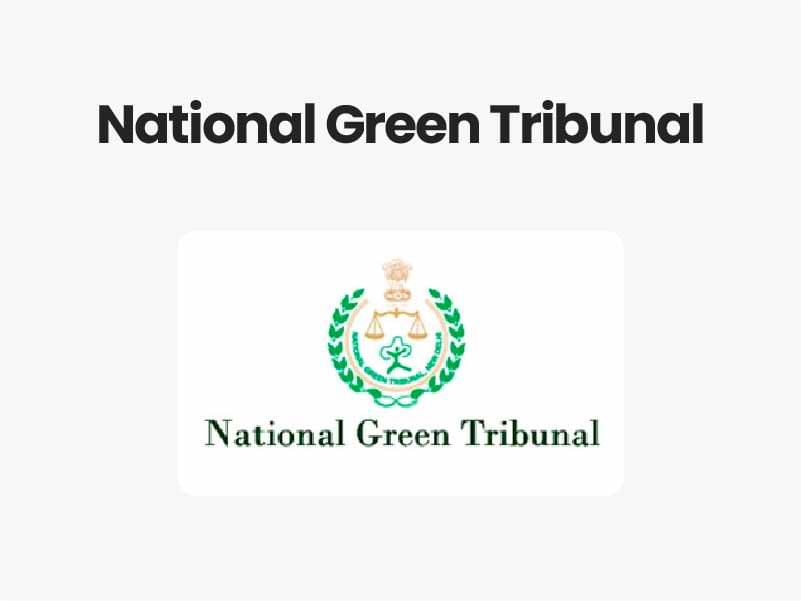Companion@360 → 7 Month programme to sharpen your writing skills → REGISTER NOW

National Green Tribunal
The National Green Tribunal has been established on 18.10.2010 under the National Green Tribunal Act 2010 for effective and expeditious disposal of cases relating to environmental protection and conservation of forests and other natural resources. Including enforcement of any legal right relating to the environment and giving relief and compensation for damages to persons and property and for matters connected therewith or incidental thereto. India is the third country in the world – after Australia and New Zealand – to set up such a body to deal with environmental cases.
Objectives of National Green Tribunal
- It is a specialized body equipped with the necessary expertise to handle environmental disputes involving multi-disciplinary issues.
- The Tribunal shall not be bound by the procedure laid down under the Code of Civil Procedure, 1908, but shall be guided by principles of natural justice.
- The Tribunal’s dedicated jurisdiction in environmental matters shall provide speedy environmental justice and help reduce the burden of litigation in the higher courts.
- The Tribunal is mandated to make and endeavour for disposal of applications or appeals finally within 6 months of filing of the same.
- Initially, the NGT is proposed to be set up at five places of sittings and will follow the circuit procedure for making itself more accessible.
- New Delhi is the Principal Place of Sitting of the Tribunal and Bhopal, Pune, Kolkata, and Chennai shall be the other four place of sitting of the Tribunal.
- To achieve the objective of Article 21, 47 and 51A (g) of the Constitution of India by means of fair, fast, and satisfactory judicial procedure.
Structure of NGT
- The Tribunal comprises of the Chairperson, the Judicial Members and Expert Members. They shall hold office for a term of five years and are not eligible for reappointment.
- The Chairperson is appointed by the Central Government in consultation with Chief Justice of India (CJI).
- A Selection Committee shall be formed by central government to appoint the Judicial Members and Expert Members.
- There are to be least 10 and maximum 20 full time Judicial members and Expert Members in the tribunal.
Powers of NGT
- NGT provides a way for the evolution of environmental jurisprudence through the development of an alternative dispute resolution mechanism.
- It helps in the reduction of the litigation burden on environmental matters in the higher courts.
- NGT provides a faster solution for various environment-related disputes that are less formal and less expensive.
- It curbs environment-damaging activities. NGT ensures the strict observation of the Environment Impact Assessment process.
- NGT provides reliefs and compensations for any damages caused to persons and properties.
- The National Green Tribunal resolves various civil cases under the following seven laws that are related to the environment:
- Water Act (Prevention and Control of Pollution), 1974
- Water Cess Act (Prevention and Control of Pollution), 1977
- Forest Act (Conservation), 1980
- Air Act (Prevention and Control of Pollution), 1981
- Environment (Protection) Act, 1986
- Public Liability Insurance Act, 1991
- Biological Diversity Act, 2002
Important Landmark Judgements of NGT:
The NGT has delivered a number of high-profile judgments. Most recently, it made it illegal for diesel vehicles over 15 years old from plying on the roads of Delhi, in a bid to tackle heavy air pollution. The body has also issued the cancellation of clearance to coal blocks in the Hasdeo-Arand forests of Chhattisgarh.
- In 2012, POSCO a steelmaker company signed a MoU with the Odisha government to set up steel project. NGT suspended order and this was considered a radical step in favour of the local communities and forests.
- In 2013 in Uttarakhand floods case, the Alaknanda Hydro Power Co. Ltd. was ordered to compensate to the petitioner – here, the NGT directly relied on the principle of ‘polluter pays’.
- In 2015, the NGT ordered that all diesel vehicles over 10 years old will not be permitted to ply in Delhi-NCR.
The NGT, in 2017, imposed an interim ban on plastic bags of less than 50-micron thickness in Delhi because “they were causing animal deaths, clogging sewers and harming the environment”.
Challenges:
For a tribal trying to stop pollution from an iron ore mine in Bastar, this means filing and fighting a case in Bhopal. This is neither easy nor affordable. Conflicts are brewing between NGT and the high courts. As per the NGT Act, appeals from NGT can only go to the Supreme Court, thus by-passing the high courts.Backlog of cases in NGT as another reason for the institution’s failure to address environmental matters.
- Two important acts – Wildlife (Protection) Act, 1972 and Scheduled Tribes and Other Traditional Forest Dwellers (Recognition of Forest Rights) Act, 2006 have been kept out of NGT’s jurisdiction.
- This restricts the jurisdiction area of NGT and at times hampers its functioning as crucial forest rights issue is linked directly to environment.
Way forward
- System of Larger Bench in NGT
- Judicial review is an important power that must be given to NGT
- We should include other environment-related laws within NGT’S ambit.
- We must strengthen it by giving it more powers and by investing in strengthening its infrastructure
- Collaborative Approach
